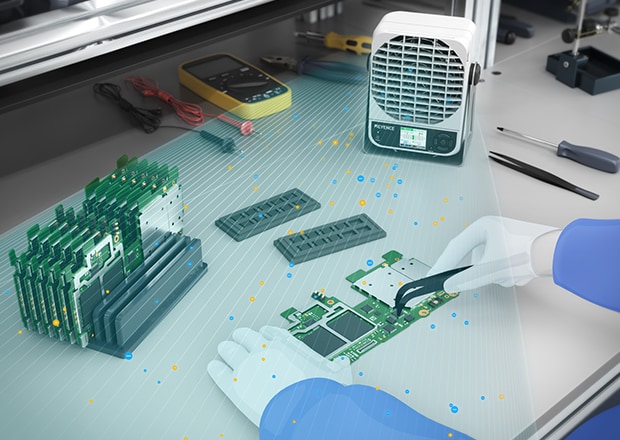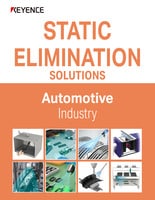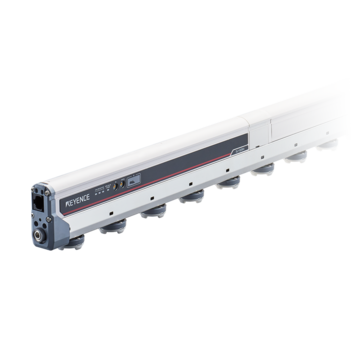Static Control
- Multi-Sensor Ionizer SJ-F700 series
- High-Accuracy High-Speed Sensing Ionizer SJ-Q series
- Energy-Saving High-Speed Sensing Ionizer SJ-E series
- Air-Free High Speed Sensing Ionizer SJ-H series
- Compact Nozzle Static Eliminator SJ-LM series
- Ultra-durable, High-power Static Elimination Gun SJ-LG series
- Compact Fan Static Eliminator SJ-LF series
- High-Performance Micro Static Eliminators SJ-M series
- Inline Electrostatic Sensor SK series
- Electrostatic Sensor SK-H series
Static Control Solutions for the Automotive Industry
Static problems in automotive plants can drive up scrap, slow the line, and eat into margins. Whether it’s missed coatings or debris on high-gloss trim, charge buildup creates real friction from molding to final inspection.
We’re here to provide you with more details.
Reach out today!

Why Static Control Matters in Automotive Manufacturing
The Role of Electrostatic Discharge
Electrostatic discharge (ESD) is a quiet failure point. One spark is all it takes to damage a PCB, throw off a sensor, or degrade the life of a control unit. And in most cases, it happens before anyone notices. Basic grounding steps help, but they don’t account for movement, friction, or handling off the bench. That’s where ionization comes in. It neutralizes charge at the air level, covering the gaps left by traditional ESD precautions.
Risks to Components and Production Efficiency
Static decreases production efficiency and component quality. In molding lines, parts stick to dies. In paint shops, dust clings to bumpers. On inspection tables, debris settles on clean surfaces. That means longer cycles, more rework, and higher scrap rates. Contaminated components don’t pass quality control, and faulty systems don’t last on the road. Left unaddressed, static slows down production and chips away at both yield and reliability.
Key Areas of Static Control Applications in the Automotive Industry
Paint Shops and Bodywork
Bumpers don’t come out of the mold clean. As they move toward coating, charged surfaces attract airborne debris. Wiping each one slows down the line; even then, it’s no guarantee. An ionizer placed between molding and paint neutralizes the surface before particles can stick.
Electronics Assembly Lines
At every step of PCB production (when they’re handled, stacked, and moved), there is a chance to generate a charge. Ionizers placed above the line keep airborne voltage in check, reducing the risk of component degradation or latent faults.
Injection Molding and Packaging
Plastic picks up static charge fast. During cooling, ejection, and packing, that static can cause sticking, slowdowns, or even cosmetic defects. Ionizers clear the field, letting parts move freely and stay clean through to final packaging.
Discover more about this product.
Click here to book your demo.

Benefits of Industrial Static Control Applications
Improved Product Quality
Production lines get sharper when parts stop attracting debris and components stop getting zapped; paint lays flat, PCBs pass tests, and products ship clean.
Fewer Defects and Downtime
Shaving seconds off of cycle times adds up. Removing static cuts defect rates and rework hours. In some applications, downtime dropped 25% just by eliminating charge in the right spot.
Better Compliance and Worker Safety
Some processes use solvents and sprays. Add static, and you introduce ignition risk. Ionizers reduce that risk at the source while helping lines hit cleanliness and traceability standards.
Some further benefits of automatic static control include:
Preventing Plastic Parts from Adhering to Molds

Molded parts generate static electricity very easily, which can cause them to stick to the mold until they fall off later. This problem increases the cost in terms of time and money spent disposing of the defective parts and removing them from the mold. An ionizer can eliminate this problem.
Preventing Electrostatic Destruction of Electronic PCBs

Static electricity is generated by debonding and friction when using PCBs. Even when grounding and other countermeasures are taken, they are usually inadequate. An ionizer can make static electricity countermeasures significantly more effective.
Preventing Adhesion of Trim Waste

When a plastic part, such as an instrument panel, is cut, waste material from this process remains attached to the part. To avoid potential damage, this waste must be blown off – an air-supplied ionizer can do just that.
Eliminating Static Charge During Bumper Coating

After a bumper is cast, foreign particles can adhere to it when it is transported to the coating process. Wiping bumpers so that they are clean enough to meet coating quality standards is time-consuming and laborious. In the worst-case scenario, bumpers may even have to be disposed of as a result of foreign particles. This problem can be avoided with an ionizer.
Curious about our pricing?
Click here to find out more.

Why Choose KEYENCE for Automotive Static Control?
Innovative Devices and Sensors
KEYENCE ionizers for automotive manufacturing and other industrial applications, like the SJ-Q Series and the SJ-F700 Series, are fast, compact, and built for precision automatic static control. They eliminate charge without blasting airflow across sensitive parts.
Easy Integration with Existing Equipment
KEYENCE devices fit directly into your line, mounted above conveyors, next to robots, or inside enclosures. No maintenance, no guesswork.
Global Support and Industry Experience
KEYENCE teams provide on-site static evaluations, free demo units, and hands-on support to find the right solution.
Contact us to learn more about how our advanced technology can help take your business to the next level.
Contact Us




